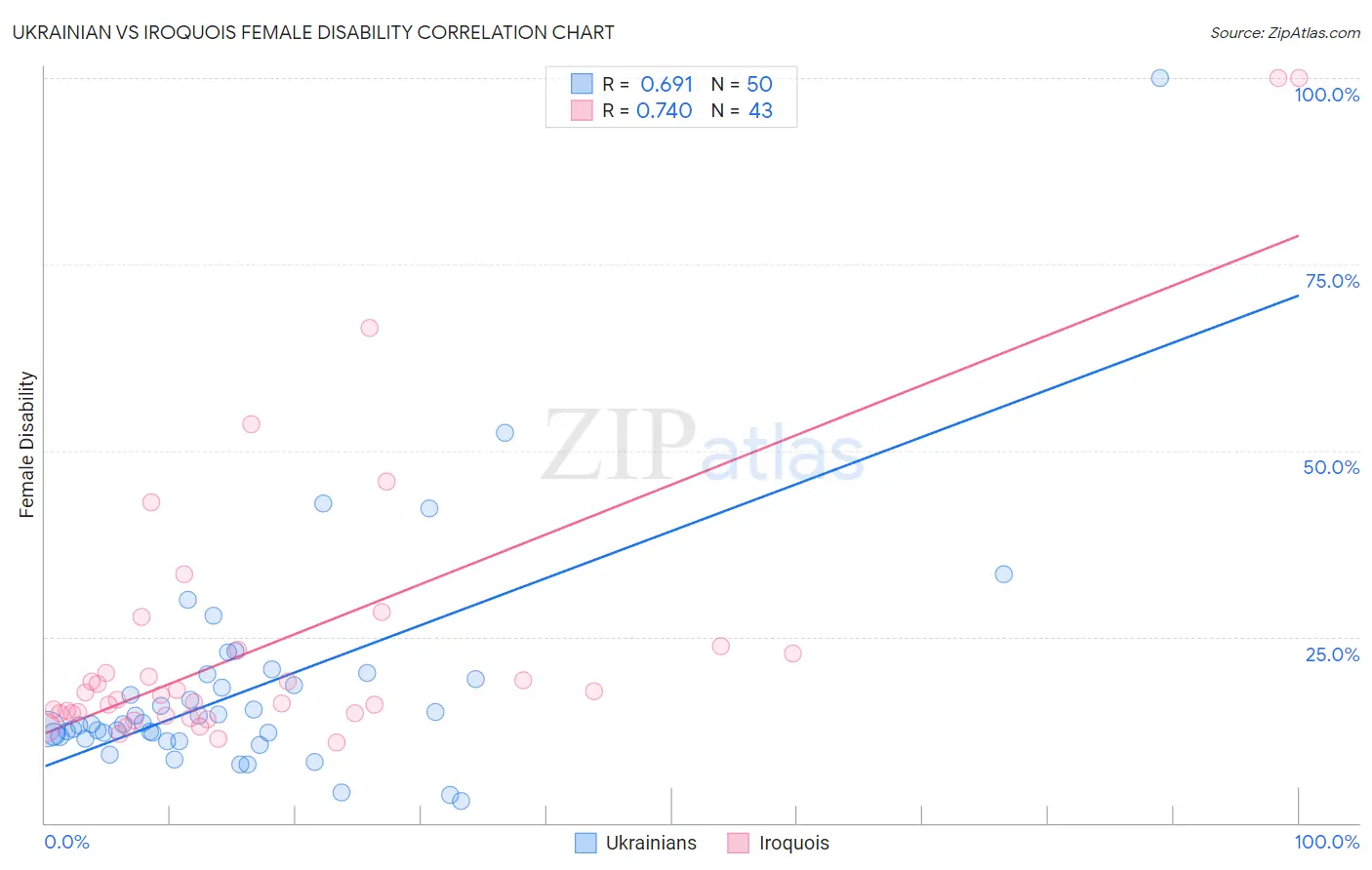Ukrainian vs Iroquois Female Disability
COMPARE
Ukrainian
Iroquois
Female Disability
Female Disability Comparison
Ukrainians
Iroquois
12.3%
FEMALE DISABILITY
27.2/ 100
METRIC RATING
194th/ 347
METRIC RANK
14.0%
FEMALE DISABILITY
0.0/ 100
METRIC RATING
319th/ 347
METRIC RANK
Ukrainian vs Iroquois Female Disability Correlation Chart
The statistical analysis conducted on geographies consisting of 448,602,757 people shows a significant positive correlation between the proportion of Ukrainians and percentage of females with a disability in the United States with a correlation coefficient (R) of 0.691 and weighted average of 12.3%. Similarly, the statistical analysis conducted on geographies consisting of 207,273,791 people shows a strong positive correlation between the proportion of Iroquois and percentage of females with a disability in the United States with a correlation coefficient (R) of 0.740 and weighted average of 14.0%, a difference of 14.1%.

Female Disability Correlation Summary
| Measurement | Ukrainian | Iroquois |
| Minimum | 2.9% | 10.9% |
| Maximum | 100.0% | 100.0% |
| Range | 97.1% | 89.1% |
| Mean | 18.0% | 24.5% |
| Median | 13.3% | 17.2% |
| Interquartile 25% (IQ1) | 11.6% | 14.7% |
| Interquartile 75% (IQ3) | 19.4% | 23.2% |
| Interquartile Range (IQR) | 7.7% | 8.6% |
| Standard Deviation (Sample) | 15.3% | 20.4% |
| Standard Deviation (Population) | 15.1% | 20.2% |
Similar Demographics by Female Disability
Demographics Similar to Ukrainians by Female Disability
In terms of female disability, the demographic groups most similar to Ukrainians are Northern European (12.3%, a difference of 0.010%), Swedish (12.3%, a difference of 0.030%), Immigrants from Panama (12.3%, a difference of 0.080%), Honduran (12.3%, a difference of 0.080%), and Immigrants from Western Africa (12.3%, a difference of 0.090%).
| Demographics | Rating | Rank | Female Disability |
| Serbians | 33.1 /100 | #187 | Fair 12.3% |
| Immigrants | North America | 32.8 /100 | #188 | Fair 12.3% |
| Immigrants | Albania | 31.6 /100 | #189 | Fair 12.3% |
| Immigrants | Honduras | 31.3 /100 | #190 | Fair 12.3% |
| Armenians | 29.7 /100 | #191 | Fair 12.3% |
| Immigrants | Western Africa | 29.2 /100 | #192 | Fair 12.3% |
| Northern Europeans | 27.5 /100 | #193 | Fair 12.3% |
| Ukrainians | 27.2 /100 | #194 | Fair 12.3% |
| Swedes | 26.6 /100 | #195 | Fair 12.3% |
| Immigrants | Panama | 25.5 /100 | #196 | Fair 12.3% |
| Hondurans | 25.4 /100 | #197 | Fair 12.3% |
| Mexican American Indians | 24.9 /100 | #198 | Fair 12.3% |
| Immigrants | Trinidad and Tobago | 24.7 /100 | #199 | Fair 12.3% |
| Trinidadians and Tobagonians | 22.4 /100 | #200 | Fair 12.3% |
| Chinese | 22.1 /100 | #201 | Fair 12.3% |
Demographics Similar to Iroquois by Female Disability
In terms of female disability, the demographic groups most similar to Iroquois are Paiute (14.0%, a difference of 0.29%), American (14.1%, a difference of 0.34%), Chippewa (14.0%, a difference of 0.40%), Potawatomi (14.1%, a difference of 0.48%), and Pueblo (14.1%, a difference of 0.49%).
| Demographics | Rating | Rank | Female Disability |
| Delaware | 0.0 /100 | #312 | Tragic 13.8% |
| Blackfeet | 0.0 /100 | #313 | Tragic 13.8% |
| Puget Sound Salish | 0.0 /100 | #314 | Tragic 13.8% |
| Alaskan Athabascans | 0.0 /100 | #315 | Tragic 13.9% |
| Spanish Americans | 0.0 /100 | #316 | Tragic 14.0% |
| Chippewa | 0.0 /100 | #317 | Tragic 14.0% |
| Paiute | 0.0 /100 | #318 | Tragic 14.0% |
| Iroquois | 0.0 /100 | #319 | Tragic 14.0% |
| Americans | 0.0 /100 | #320 | Tragic 14.1% |
| Potawatomi | 0.0 /100 | #321 | Tragic 14.1% |
| Pueblo | 0.0 /100 | #322 | Tragic 14.1% |
| Blacks/African Americans | 0.0 /100 | #323 | Tragic 14.1% |
| Natives/Alaskans | 0.0 /100 | #324 | Tragic 14.1% |
| Navajo | 0.0 /100 | #325 | Tragic 14.2% |
| Comanche | 0.0 /100 | #326 | Tragic 14.2% |